1 of 19
Downloaded 13 times




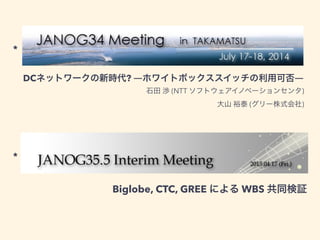
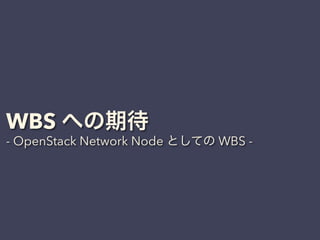


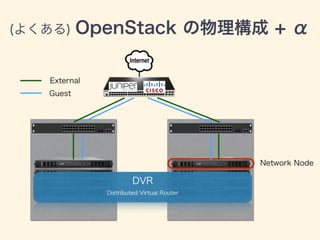



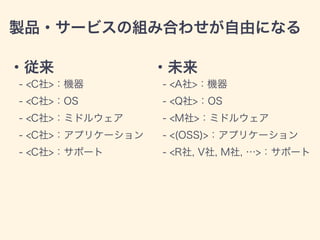
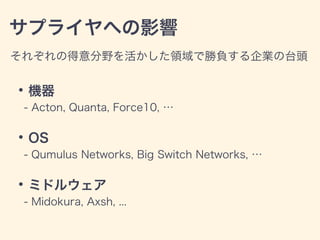
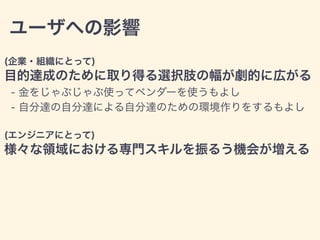




Ad
Recommended
OSSのクラウド基盤 OpenStack / CloudStack
OSSのクラウド基盤 OpenStack / CloudStackVirtualTech Japan Inc.
?
「OSSのクラウド基盤 OpenStack / CloudStack」勉強会向け資料です。
クラウト?運用のヘ?ストフ?ラクティスを考える - OpenStack最新情報セミナー(2016年12月)
クラウト?運用のヘ?ストフ?ラクティスを考える - OpenStack最新情報セミナー(2016年12月)VirtualTech Japan Inc.
?
CD(継続的デリバリー)手法を用いたサーバシステム構築の自動化 - OpenStack最新情報セミナー(2016年12月)
講師:熊谷 理那(ミラクル?リナックス)
アジェンダ:
おうち Lab で GitDNSOps / GitDNS Ops in My Home Lab
おうち Lab で GitDNSOps / GitDNS Ops in My Home LabMotonori Shindo
?
VMware DevOps Meetup #10での登壇資料です。
「おうち Lab」の構成の紹介と、そこで行っている GitDNSOps について解説をしています。【Sb】「if 自動化するなら then stack stormを使おう」 展開用
【Sb】「if 自動化するなら then stack stormを使おう」 展開用Kazunori Shimura(kojima)
?
2017-03-23(Thu) StackStorm勉強会 第2回 発表資料
【Cisco OpenStack Seminar 2015.10.26】 OpenStackrealize the private cloud - Ope...
【Cisco OpenStack Seminar 2015.10.26】 OpenStackrealize the private cloud - Ope...シスコシステムズ合同会社
?
2015年10月26日(月)に開催した「Cisco OpenStack Private Seminar」の資料です。Interact 2019:Microsoft SDN v2 よもやま話
Interact 2019:Microsoft SDN v2 よもやま話wind06106
?
Interact 2019:Talk on various subjects for Microsoft SDN v2 for Interact 2019 in JapanOpenStack批評 2015
OpenStack批評 2015Masahiro Nakazato
?
OpenStackを利用した比較的大規模なパブリッククラウドサービス を企画から運用している体験からの感想談&考察です
ネットワークエンジニア&中間管理職の視点となっています
1. 紹介情報 2. 感想
3. 考察
の三部構成です
導入の意思決定の参考になれば幸いです???July Tech Festa 2020 AKSを活用した内製教育支援プラットフォームをリリースした話
July Tech Festa 2020 AKSを活用した内製教育支援プラットフォームをリリースした話Shingo Kawahara
?
July Tech Festa 2020 Dトラック 11:00~ に登壇させて頂いた資料ですStackStorm で実現する、複数システムに対する統一インターフェイス提供と運用一元化の取り組み - OpenStack最新情報セミナー(2017年3月)
StackStorm で実現する、複数システムに対する統一インターフェイス提供と運用一元化の取り組み - OpenStack最新情報セミナー(2017年3月)VirtualTech Japan Inc.
?
タイトル:StackStorm で実現する、複数システムに対する統一インターフェイス提供と運用一元化の取り組み - OpenStack最新情報セミナー(2017年3月)
アジェンダ:
- 課題認識
- 解決策
--- システムの統合
--- システムの抽象化
--- StackStormによるシステムの抽象化20150616 ohyama
20150616 ohyamaOhyama Hiroyasu
?
「OpenStack 超入門」発表資料
https://itmedia.smartseminar.jp/public/application/add/1054サーバーの脆弱性管理に関して(OpenStack + Vuls) - OpenStack最新情報セミナー(2016年12月)
サーバーの脆弱性管理に関して(OpenStack + Vuls) - OpenStack最新情報セミナー(2016年12月)VirtualTech Japan Inc.
?
サーバーの脆弱性管理に関して(OpenStack + Vuls) - OpenStack最新情報セミナー(2016年12月)
講師:岩本 裕真(BBT)
アジェンダ:
- 皆さんはサーバの脆弱性管理をどのように行っていますか?
- demoあなたも「違いが分かる人」になりましょう! ~ Azure, AzureStack, AzureStack HCI ~
あなたも「違いが分かる人」になりましょう! ~ Azure, AzureStack, AzureStack HCI ~Masahiko Ebisuda
?
「Interact 2019」の1セッションとして実施させていただきました。Azure, Azure Stack, Azure Stack HCIのそれぞれの概要と違いの解説を中心にしながら、「クラウド」と「仮想基盤」の違いと、それぞれの使い方の「スタイル」に関して解説しています。
Topics2: to confirm WBS for operation this week
Topics2: to confirm WBS for operation this weekkoichi ikeda
?
I open the WBS for this week operation
you can check them out.Director's High Vol.1 -WBSの作り方-
Director's High Vol.1 -WBSの作り方-Granfairs.inc
?
2013年6月30日に開催したWebディレクション講座「Director's High Vol1 -WBSの作り方-」で使用したスライドです。More Related Content
What's hot (20)
クラウト?運用のヘ?ストフ?ラクティスを考える - OpenStack最新情報セミナー(2016年12月)
クラウト?運用のヘ?ストフ?ラクティスを考える - OpenStack最新情報セミナー(2016年12月)VirtualTech Japan Inc.
?
CD(継続的デリバリー)手法を用いたサーバシステム構築の自動化 - OpenStack最新情報セミナー(2016年12月)
講師:熊谷 理那(ミラクル?リナックス)
アジェンダ:
おうち Lab で GitDNSOps / GitDNS Ops in My Home Lab
おうち Lab で GitDNSOps / GitDNS Ops in My Home LabMotonori Shindo
?
VMware DevOps Meetup #10での登壇資料です。
「おうち Lab」の構成の紹介と、そこで行っている GitDNSOps について解説をしています。【Sb】「if 自動化するなら then stack stormを使おう」 展開用
【Sb】「if 自動化するなら then stack stormを使おう」 展開用Kazunori Shimura(kojima)
?
2017-03-23(Thu) StackStorm勉強会 第2回 発表資料
【Cisco OpenStack Seminar 2015.10.26】 OpenStackrealize the private cloud - Ope...
【Cisco OpenStack Seminar 2015.10.26】 OpenStackrealize the private cloud - Ope...シスコシステムズ合同会社
?
2015年10月26日(月)に開催した「Cisco OpenStack Private Seminar」の資料です。Interact 2019:Microsoft SDN v2 よもやま話
Interact 2019:Microsoft SDN v2 よもやま話wind06106
?
Interact 2019:Talk on various subjects for Microsoft SDN v2 for Interact 2019 in JapanOpenStack批評 2015
OpenStack批評 2015Masahiro Nakazato
?
OpenStackを利用した比較的大規模なパブリッククラウドサービス を企画から運用している体験からの感想談&考察です
ネットワークエンジニア&中間管理職の視点となっています
1. 紹介情報 2. 感想
3. 考察
の三部構成です
導入の意思決定の参考になれば幸いです???July Tech Festa 2020 AKSを活用した内製教育支援プラットフォームをリリースした話
July Tech Festa 2020 AKSを活用した内製教育支援プラットフォームをリリースした話Shingo Kawahara
?
July Tech Festa 2020 Dトラック 11:00~ に登壇させて頂いた資料ですStackStorm で実現する、複数システムに対する統一インターフェイス提供と運用一元化の取り組み - OpenStack最新情報セミナー(2017年3月)
StackStorm で実現する、複数システムに対する統一インターフェイス提供と運用一元化の取り組み - OpenStack最新情報セミナー(2017年3月)VirtualTech Japan Inc.
?
タイトル:StackStorm で実現する、複数システムに対する統一インターフェイス提供と運用一元化の取り組み - OpenStack最新情報セミナー(2017年3月)
アジェンダ:
- 課題認識
- 解決策
--- システムの統合
--- システムの抽象化
--- StackStormによるシステムの抽象化20150616 ohyama
20150616 ohyamaOhyama Hiroyasu
?
「OpenStack 超入門」発表資料
https://itmedia.smartseminar.jp/public/application/add/1054サーバーの脆弱性管理に関して(OpenStack + Vuls) - OpenStack最新情報セミナー(2016年12月)
サーバーの脆弱性管理に関して(OpenStack + Vuls) - OpenStack最新情報セミナー(2016年12月)VirtualTech Japan Inc.
?
サーバーの脆弱性管理に関して(OpenStack + Vuls) - OpenStack最新情報セミナー(2016年12月)
講師:岩本 裕真(BBT)
アジェンダ:
- 皆さんはサーバの脆弱性管理をどのように行っていますか?
- demoあなたも「違いが分かる人」になりましょう! ~ Azure, AzureStack, AzureStack HCI ~
あなたも「違いが分かる人」になりましょう! ~ Azure, AzureStack, AzureStack HCI ~Masahiko Ebisuda
?
「Interact 2019」の1セッションとして実施させていただきました。Azure, Azure Stack, Azure Stack HCIのそれぞれの概要と違いの解説を中心にしながら、「クラウド」と「仮想基盤」の違いと、それぞれの使い方の「スタイル」に関して解説しています。
StackStorm で実現する、複数システムに対する統一インターフェイス提供と運用一元化の取り組み - OpenStack最新情報セミナー(2017年3月)
StackStorm で実現する、複数システムに対する統一インターフェイス提供と運用一元化の取り組み - OpenStack最新情報セミナー(2017年3月)VirtualTech Japan Inc.
?
Viewers also liked (8)
Topics2: to confirm WBS for operation this week
Topics2: to confirm WBS for operation this weekkoichi ikeda
?
I open the WBS for this week operation
you can check them out.Director's High Vol.1 -WBSの作り方-
Director's High Vol.1 -WBSの作り方-Granfairs.inc
?
2013年6月30日に開催したWebディレクション講座「Director's High Vol1 -WBSの作り方-」で使用したスライドです。奥叠厂を始めよう
奥叠厂を始めようTakashi Yoshimura
?
罢辞顿辞リストは日々の忘备録には确かに便利だけど、复数のタスクを管理するには向いてない。プロジェクト管理で一般的に用いられている奥叠厂を、日々の生活にも导入することで、罢辞顿辞リストとは违った生活を手に入れよう!Ad
More from Ohyama Hiroyasu (9)
OpenInfra Summit Vancouver 2023 - SSoT
OpenInfra Summit Vancouver 2023 - SSoTOhyama Hiroyasu
?
The document discusses the importance of a Single Source of Truth (SSOT) for efficient infrastructure operation at DMM.com, highlighting past struggles with scattered data and duplication. It outlines the transition to managing comprehensive information through a unified system called Airone, enabling better data structure, access control, and streamlined operations. Key aspects include overcoming past hardships, ideal information management, and future application use cases for infrastructure deployment.StackStorm Meetup JP #7 発表資料
StackStorm Meetup JP #7 発表資料Ohyama Hiroyasu
?
The document describes different versions of a system that provides authentication for users to access multiple services. Version 2.x allowed a single user "ST2" to access Services A and B. Version 3.0 introduced individual authentication for each service, so attempts by User B to access Services outside their authorization were denied. The document provides example logs of users authenticating and accessing services under different versions of the system.20190424 stackstorm-meetup5
20190424 stackstorm-meetup5Ohyama Hiroyasu
?
The document describes an automated workflow system. The system allows users to create workflows by connecting triggers to actions through a graphical user interface. Triggers can come from sensors, other systems, or rules, and initiate checks that dispatch tasks to downstream systems or services. The system provides monitoring, auditing, and reporting to give users visibility into workflow executions and their outcomes.[OSC2016] マイクロサービスを支える MQ を考える
[OSC2016] マイクロサービスを支える MQ を考えるOhyama Hiroyasu
?
This document discusses message queues (MQ) and their use for microservices. It defines MQ as a mechanism that supports asynchronous message passing between application processes. The key benefits of using MQ for microservices are that it allows for high availability, scalability, and handling new/stopped services. The document compares different MQ protocols and implementations like AMQP, MQTT, Kafka, and ZeroMQ. It provides examples of how companies like Yahoo Japan, IBM and OpenStack use MQ. Performance-oriented MQs like NewtMQ and NATS are also discussed. The conclusion is that NATS is better for microservices if its restrictions can be permitted, but the best choice depends on the specific application requirements.jtf2016-mom
jtf2016-momOhyama Hiroyasu
?
The document discusses different types of message-oriented middleware (MOM) technologies. It provides an overview of common MOM protocols including AMQP, MQTT, STOMP, and Kafka. For each protocol, it describes features such as message delivery guarantees, pub/sub capabilities, and performance characteristics regarding traffic and CPU usage.Ad
20150513 wbsユーサ?会資料-大山
- 1. OpenStack を運用するシステム屋から見た WBS への期待と未来予想 グリー株式会社 インフラストラクチャ本部 大山 裕泰 (オオヤマ ヒロヤス) 第一回:ホワイトボックススイッチユーザ会 - 20150513
- 2. 自己绍介
- 3. 大山 裕泰 所属:グリー株式会社 / インフラ本部 (OpenStack による) お仕事:Private Cloud 環境の開発/運用 詳しくは CEDEC 2015 で!!
- 5. DCネットワークの新時代? ―ホワイトボックススイッチの利用可否― Biglobe, CTC, GREE による WBS 共同検証 * * 石田 渉 (NTT ソフトウェアイノベーションセンタ) 大山 裕泰 (グリー株式会社)
- 7. 製品?サービスの組み合わせが自由になる ?従来 - <C社>:機器 - <C社>:OS - <C社>:ミドルウェア - <C社>:アプリケーション - <C社>:サポート ?未来 - <A社>:機器 - <Q社>:OS - <M社>:ミドルウェア - <(OSS)>:アプリケーション - <R社, V社, M社, …>:サポート
- 8. サプライヤへの影響 ?機器 - Acton, Quanta, Force10, … ?OS - Qumulus Networks, Big Switch Networks, … ?ミドルウェア - Midokura, Axsh, ... それぞれの得意分野を活かした領域で勝負する企業の台頭
- 10. WBS 自体の課題
- 11. (まだ) 完全に "ホワイト" ではない ?ブラックボックス (チップドライバ) の存在 ?気軽に触れない
- 12. WBS への期待 - OpenStack Network Node としての WBS -
- 13. OpenStack のネットワーク論理構成 OpenStack Manual Networking architecture より抜粋
- 15. (よくある) OpenStack の物理構成 + α Network Node External Guest DVR Distributed Virtual Router
- 16. 従来の使い方の難点 ?ネットワーク装置としてのサーバの存在 - ネットワークノードがボトルネックになりうる - ネットワークノードと ToR 間の余計な折り返し通信 ?特定のベンダーに依存する - 異なるベンダーのサービスプラグインを同時に使えない
- 17. WBS + OpenStack の物理構成 External Guest WBS L3 Agent, 各種 NFV など 試したかった
- 18. だが、無理だった。 (2014年12月の時点では) (cumulus 2.2 では OVS が入らない…)